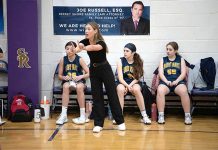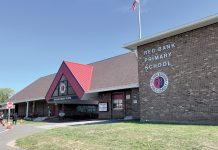
RUMSON – The Rumson Country Day School (RCDS) second graders may not have been alive when Super Storm Sandy hit the Jersey Shore in 2012, but they are certainly learning its lessons by designing and building coastal homes that can withstand simulated floodwaters and high winds.
The hands-on project is a STEAM challenge second grade students tackle each year using the Engineering Design Process (EDP), a cyclical exercise that prompts students to think and solve problems like engineers.
“The Engineering Design Process involves these steps – ask, imagine, plan, create, test, improve, share,” explained Jennifer Grolemund, RCDS’s Lower School science teacher, who has tasked students with a variety of STEAM challenges using EDP for the past four years. “This is what distinguishes STEAM from science. It’s a step-by-step process, with students creating something tangible to meet a very specific function.”
Grolemund, who has worked as a field biologist and holds an master’s degree in curriculum and teaching from Columbia University, strives to make STEAM projects relevant to students’ lives.
“We’re very intentional about these projects,” she said. “It’s not just, ‘Go and invent an alien.’ We reframe a question with real and meaningful connections to life that students can then solve as engineers. Asking our second graders to construct a house that can withstand a storm is applicable to real life, especially since we live near the Jersey Shore.”
The Hurricane House project is also integrated with the second grade’s in-depth study of earth science. Earlier in the year, children studied geology, tectonic plates and earthquakes. In March, they moved on to extreme weather, a subject that is fascinating to 7- and 8-year-olds, according to Grolemund.
“Kids are very interested in storms, especially the physical damage they can cause. Seeing a tree that’s been uprooted from a hurricane really piques their interest. You see their eyes get huge when we start talking about, ‘How can engineers make our lives safer?’”
Working from a set list of materials, second graders designed and constructed their homes using prescribed mathematical parameters in terms of height, width and elevation. Brendan Fallon, an 8-year-old from Rumson, used an egg carton and boxes, and tried elevating his home above the required 12 centimeters to withstand the deluge of the flood tray and the gale of the wind machine. He noticed that the legs on his model weren’t quite even and made last-minute adjustments that helped his model pass muster on the first test.
“The legs all have to be the same size or the house would topple over,” he explained. “More wind or water may damage it, so if I made it again, I would like to make a barrier around the house to protect it more.”
Grolemund underscored the importance of collaboration, even though it looked a little different this year due to COVID-19. “The students typically work in small groups or pairs during this project,” she said. “This year they worked independently, but still shared ideas, setbacks, and discoveries with one another. By collaborating in class, the students gain multiple perspectives and problem-solve more efficiently.”
Like Brendan, 8-year-old Samantha Leasor of Fair Haven said it was challenging to get the legs even on an elevated home. She went back to the drawing board to make improvements. “I ripped (my house) apart and lined up the legs so they are all the same length. Then I put them back on the house and it worked. I knew I had to fix it and it felt good when I did.”
Grolemund purposely builds in a lot of time for second graders to test and refine their designs.
“That’s one of the biggest parts of the Engineering Design Process,” she said. “It might take a student three, four, or five tries to get it right. That can be frustrating at age 7 or 8, but we work through it. The STEAM process instills persistence. Students learn how to assess what’s working, what’s not working, and how to make improvements to better their idea. The bigger lesson is sticking with your idea until you get it right.”
That’s a lesson seven-year-old Margaret Smith of Rumson has taken to heart. “Even if it doesn’t work the first time, keep trying other things like layering it with tape or using a different material to make it work,” she said. “Just keep doing it.”
The article originally appeared in the April 22 – 28, 2021 print edition of The Two River Times.














